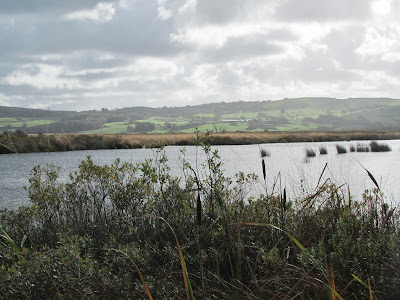Weather
condition: Windy, temperature around 150 c
My field visits to the raisedbog, Cors Fochno (Borth Bog). Cors
Fochno (Borth Bog) is a low-lying raised bog in mid wales. Cors Fochno visit was interesting but it was full
of weather fluctuations. Besides from
that, we got an opportunity to understand the bog ecology and conservation
measures applied to conserve that site with the help of ranger Mike, who is
working there for more than 25 years. He
mentioned that Cors Fochno comes under the designation of a Special Area of
Conservation (SAC), Special Protection Area (SPA), Ramsar Convention onWetlands, Biosphere site, National Nature Reserve (NNR) and Site of SpecialScientific Interest (SSSI). I think these multiple designations are
sufficient to understand, how important is this bog to Wales. So, it was a huge
opportunity to understand for fresher.
 |
| Overview of Cors Fochno |
 |
| Sphagnum with dry grass |
Cors Fochno (Borth Bog) is known to be one of the largest of 3
estuaries in North Wales and mire remained in the Britain. Mike told us, the
bog was undisturbed till 19th century, although local communities
were used to live nearby that site. Earlier communities used to utilize bog for
very organized grazing purpose only. However, with passing years pit cutting made
situation worst. Now, bog is
in quite good condition, after
conservation initiation made by them to protect.
Though many peatlands of the Britain have been lost due to the encroachment,
this area has seen no impact now days. Mike told us a story behind that. He
told us they were able to conserve the bog because that area is isolated from the
city area. Along with that the margins of the bog have been drained and
improved over the years and many restoration programs also helped to restore
it.
The management of the bog has been big concern for
the authorities since many years, in 1990 due to drainage all bog species were
wiped, they tried to revert it back by applying natural method of ditch
blocking but they were not successful. After that they keep on trying new
methods, now they use Welsh ponies and traditional breeds of cattle to control
scrub grass in the bog.
The bog has rich diversity of flora and fauna,
below given is the list of diversity found within the bog”. After survey it was
clear for me that the bog is dominated by sphagnum moss species. Mike told us
the bog has 14 species of moss in which few species are more dominant such as Sphagnum cuspidatum, Sphagnum fuscum, Sphagnumaustinii. Sphagnum cuspidatum is known to be key indicator of the bog.
Along with sphagnum, many grass species are common in this bog including cotton
grass, deer grass and common grass.
 |
| Dragonfly basking in the sunlight |
 |
| Myrica gale |
The bog is providing habitat to many insects. Among rare insects that live in the Borth Bog, it is perhaps best known for its population of the Rosy Marsh Moth (Eugraphe subrosea). It is believed that this bog has the largest population of Rosy Marsh Moth. I was shocked to know that carnivorous plant named Sundew is also found in the bog, which indicates the undisturbed condition of the bog.Good population of beetles, spiders,
dragonflies, damsel dragonfly and butterflies are very common. The field survey conducted by us gave us pH
5.34, conductivity 0.07 and depth 5 mt. That data was sufficient for us to
understand perfect example of bog.
No comments:
Post a Comment